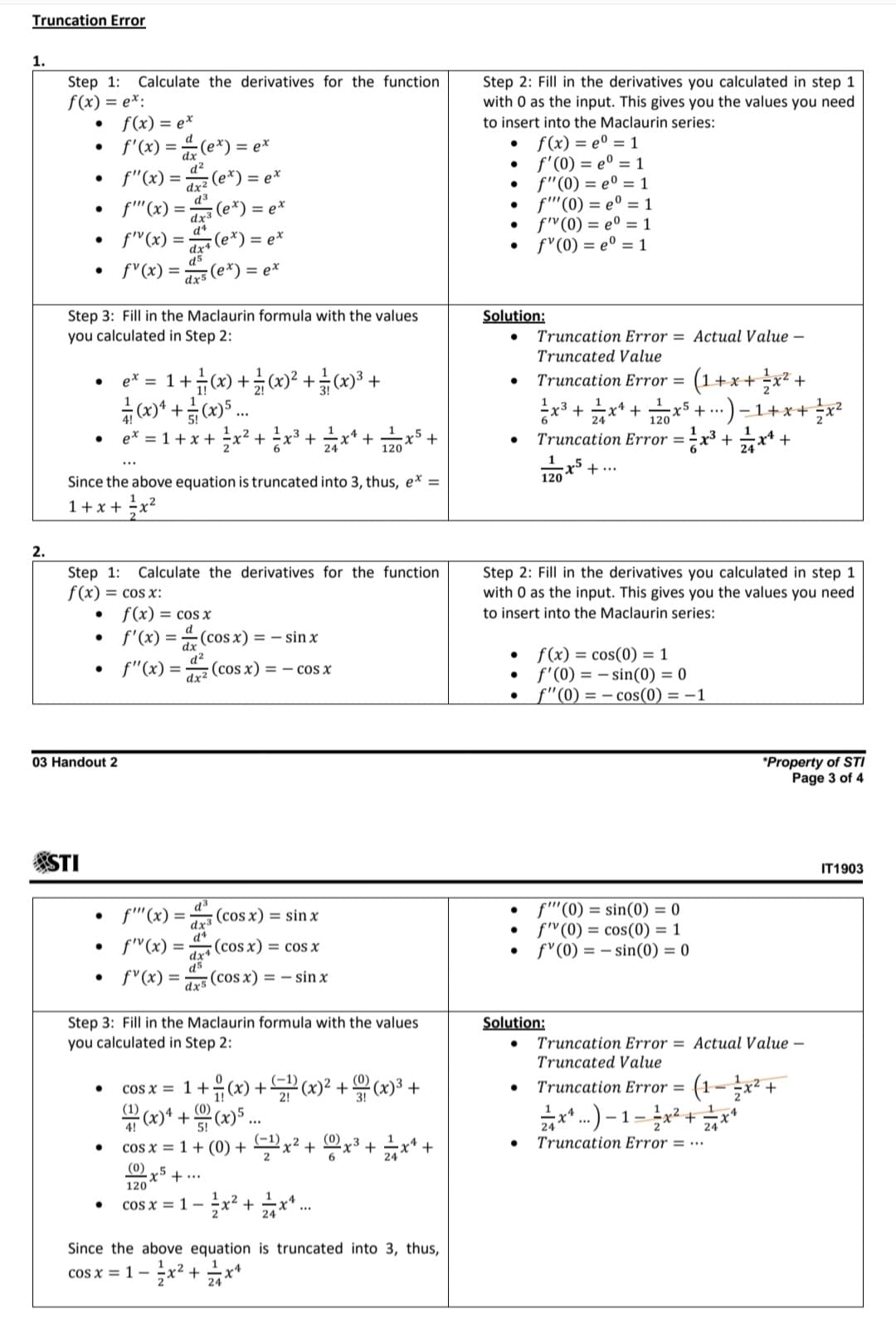1. Find the truncuated error of the Maclaurin series sinx cosx given that is truncated into 3 terms. These are the example that might help..see the picture below
1. Find the truncuated error of the Maclaurin series sinx cosx given that is truncated into 3 terms. These are the example that might help..see the picture below
Calculus: Early Transcendentals
8th Edition
ISBN:9781285741550
Author:James Stewart
Publisher:James Stewart
Chapter1: Functions And Models
Section: Chapter Questions
Problem 1RCC: (a) What is a function? What are its domain and range? (b) What is the graph of a function? (c) How...
Related questions
Question
1. Find the truncuated error of the Maclaurin series sinx cosx given that is truncated into 3 terms.
These are the example that might help..see the picture below

Transcribed Image Text:Truncation Error
1.
Step 1:
f(x) = e*:
• f(x) = e*
f'(x) = (e*) = e*
f"(x) = (e*) = e*
Calculate the derivatives for the function
Step 2: Fill in the derivatives you calculated in step 1
with 0 as the input. This gives you the values you need
to insert into the Maclaurin series:
f(x) = e° = 1
f'(0) = e° = 1
f"(0) = e° = 1
f''0) = e° = 1
f"(0) = e° = 1
f'(0) = e° = 1
d?
dx2
d3
f''(x) = (e*) = e*
dx3
dx4 (e*) = ex
d5
f"(x) =
f'(x) =
= e*
dxs (e*)
Step 3: Fill in the Maclaurin formula with the values
you calculated in Step 2:
Solution:
Truncation Error = Actual Value –
Truncated Value
(1+x+x* +
...) -1+x+ ?
Truncation Error =x + ** +
e* = 1+(x) +x)? +x)³ +
Truncation Error =
x5
120
+
6
e* = 1+x + x² + x³ + x* + 20
x5+
%3D
6
120
Since the above equation is truncated into 3, thus, e* =
1+ x + x?
2.
Step 1:
f(x) = cos x:
Step 2: Fill in the derivatives you calculated in step 1
with 0 as the input. This gives you the values you need
Calculate the derivatives for the function
f(x) = cos x
to insert into the Maclaurin series:
f'(x) = (cos x) = – sin x
f(x) = cos(0) = 1
f'(0) = – sin(0) = 0
f"(0) = – cos(0) = –1
f"(x) =
d2
(cos x) = – cos x
dx2
*Property of STI
Page 3 of 4
03 Handout 2
STI
IT1903
f''0) = sin(0) = 0
f"(0) = cos(0) = 1
f'(0) = – sin(0) = 0
f''(x) =
(cos x) = sinx
dx
f"(x) =
-(cos x) = cos x
dx
d5
drs (cos x) =– sin x
f'(x) =
Step 3: Fill in the Maclaurin formula with the values
you calculated in Step 2:
Solution:
Truncation Error = Actual Value –
Truncated Value
+유() + (3)2 + 유(2)* +
Truncation Error = (1- ;x² +
cos x =
(0)
24 *"
Truncation Error = ...
1 -
5!
24
cos X %3D 1 + (0) + 들x2 + Dx* + x*
(0)
x5 +...
120
cos x = 1 - x? + *..
Since the above equation is truncated into 3, thus,
x? + **
cos x = 1 –
Expert Solution
This question has been solved!
Explore an expertly crafted, step-by-step solution for a thorough understanding of key concepts.
This is a popular solution!
Trending now
This is a popular solution!
Step by step
Solved in 2 steps with 1 images

Recommended textbooks for you

Calculus: Early Transcendentals
Calculus
ISBN:
9781285741550
Author:
James Stewart
Publisher:
Cengage Learning

Thomas' Calculus (14th Edition)
Calculus
ISBN:
9780134438986
Author:
Joel R. Hass, Christopher E. Heil, Maurice D. Weir
Publisher:
PEARSON

Calculus: Early Transcendentals (3rd Edition)
Calculus
ISBN:
9780134763644
Author:
William L. Briggs, Lyle Cochran, Bernard Gillett, Eric Schulz
Publisher:
PEARSON

Calculus: Early Transcendentals
Calculus
ISBN:
9781285741550
Author:
James Stewart
Publisher:
Cengage Learning

Thomas' Calculus (14th Edition)
Calculus
ISBN:
9780134438986
Author:
Joel R. Hass, Christopher E. Heil, Maurice D. Weir
Publisher:
PEARSON

Calculus: Early Transcendentals (3rd Edition)
Calculus
ISBN:
9780134763644
Author:
William L. Briggs, Lyle Cochran, Bernard Gillett, Eric Schulz
Publisher:
PEARSON

Calculus: Early Transcendentals
Calculus
ISBN:
9781319050740
Author:
Jon Rogawski, Colin Adams, Robert Franzosa
Publisher:
W. H. Freeman


Calculus: Early Transcendental Functions
Calculus
ISBN:
9781337552516
Author:
Ron Larson, Bruce H. Edwards
Publisher:
Cengage Learning